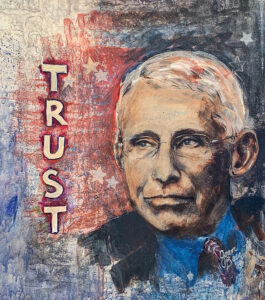
Even before the World Health Organization (WHO) declared the COVID-19 pandemic, pundits were already saying we were headed for a “new normal,” specifying ways life would change. And, after tens of millions were thrown out of work and filed for unemployment, the stakes grew higher, and the dimensions of the new normal even more frightening to contemplate. COVID triggered memories of the 1918 pandemic, which killed tens of millions, yet our deluded, deceitful President minimized it and took no concerted action to prevent spread. Many anticipated there would be sustained protests and demonstrations across the country against something. The murder of George Floyd at the hands of police shifted attention to the long-standing issue of excess brutality and systemic racism by police, stimulated demonstrations focused on the pattern of murders of blacks by police, and provided focus for the predicted marches.
While millions suffer here and abroad as a result of the pandemic, associated job losses, and the irrevocable destruction of small businesses, the effects are most severely felt among people of color, recent immigrants, and the economically disadvantaged. Still, the full effects were delayed by governmental intervention, notably payments to small businesses to keep employees on the payroll and covered by health insurance, $600 Federal supplements to State unemployment benefits, and moratoriums on eviction notices. The Senate wrangled over the dollar level at which the unemployment supplements should be extended and the continuation of the Federal moratorium on evictions. Then Mitch McConnell sent them skedaddling home for August’s month-long recess without having decided anything. Trump then attempted by Executive Order to save the day [Note from Andy Kaufmann: Mighty Mouse theme starts here] by finding a middle ground in unemployment supplements and by delaying the payment of Social Security contributions. And then little or no action was taken on the Executive Order. No doubt, many who lost jobs finally lost roof over their heads and food on the table in August. Yet, somehow, the impact apparently wasn’t as great as many expected. I’m sure we’ll soon know why.
We should not lose sight of the harsh reality that, while many are haunted by visions of the Hoovervilles that sprung up in the early 1930s, many people’s lives were hardly touched, at least directly, except that the pandemic still rages, and we’re digging ourselves so deeply into debt that there’s increasing risk of eventual currency devaluation. More than once, Trump has talked about repudiating our debt—something he has great experience at as a failed businessman. Knowing the risk, China has already sold its holdings in long-term U.S. bonds.
It’s worth looking at some of the predictions made in March for what the new normal might look like and whether these predictions panned out.
Choosing Privacy over Being with Others.
In response to public health recommendations to stay at home, it was predicted that people would actively avoid in-person interactions with others, moving instead to online connection. People reached out to friends they hadn’t talked with in years. I even began exchanging handwritten letters with several friends. Zoom flourished. Person-to-person connectivity was enhanced. I was able to take part in my first journal release parties because they were held over Zoom. We began having bi-weekly Zoom meetings with close friends.
We stopped seeing our children and grandchildren in person for safety’s sake. One day, our daughter pulled into the driveway to drop off food. I walked around the car to talk with not-quite-five-year-old Ben, whose window was open. His reaction: “not so close.” When I persisted in trying to talk with him, he said, “Daddy, close the window.” The little ones may have internalized the fear of personal contact far more than we give them credit for. With the pandemic likely to continue for as much as another year, we grow restless, yet our habits of avoiding face-to-face contact may grow deeper.
Reduced Polarization.
Some expected that by viewing the pandemic and its economic ramifications as a common enemy, we would become less polarized as a nation. But thanks to our racist, polarizing President, who can’t follow a script, we’ve watched the recommendations of public health experts infuse new energy into our polarization. Inexplicably, mask wearing came to be regarded as a threat to First Amendment rights. At the same time, in response to the Black Lives Matter protests, there were widespread demands to acknowledge our country was built on the backs of slaves and to replace memorials to slavery and the confederacy with more inclusive memorials appropriate in an increasingly non-white population. There too, Trump took the contrarian approach, and insisted we need to respect our history, meaning the Confederacy. Until he and his cronies are driven out of power, polarization will grow worse.
Resumption of Faith in Scientific Experts.
Thanks to our President’s daily press conferences, in which he repeatedly undercut health experts and the science of public health, we’ve also seen Dr. Anthony Fauci become the most trusted authority in the country on the pandemic. In times of trouble, we need heroes, and Fauci’s steadiness and refusal to be drawn into politics has made him the most trusted authority. His repeatedly reminding people that we need to look at the science has led to greater trust in science, despite all of Trump’s efforts to undercut science on every front. With any luck, this will result in widespread public support to follow the science on other fronts, especially climate change. This will endure. Thanks, Tony.
[Editor’s Note: The author attended the same high school as Tony Fauci, several years later. Since the acceptance of this essay, Dr. Fauci has been sidelined, discredited, and ignored by the Trump Administration, the lives of his family threatened. But most reasonable Americans understand his lifelong dedication to the scientific community and to the health of the American people.]
![]()

A Shift toward Telemedicine.
The technology to support telemedicine has existed for decades. It was often called “rural medicine.” What was absent was the willingness by Medicare to pay widely for telemedicine services. Therefore, most other insurance carriers wouldn’t pay either. The pandemic’s stay-at-home message changed that because it was the only way for the show to go on. This will emphatically remain part of our new normal.
Even Government Goes Virtual.
Thanks to the pandemic, which required Supreme Court justices to deliberate from home, the public had the rare opportunity to be “present” for the court’s deliberations. And Congress even experimented with virtuality, having repudiated any prospect of virtue. The trend has been established and I believe will continue because our appetites have been whetted.
Demands for Reform.
The abdication of responsibility by Trump for any responsibility throughout the COVID debacle, especially the delay on invoking the Defense Production Act to manufacture PPE, created a groundswell of support for reform. The failure to anticipate the pandemic and prepare adequately underscored the need to re-build our infrastructure, not only related to pandemic preparedness, but for the entire public health system. Indeed, it was observed early in the pandemic that it was clear we lacked a true public health system.
The Black Lives Matter movement has generated widespread public support for re-thinking the role police play in communities and for acknowledging and acting to counter systemic racism in all aspects of American society. In Europe, it has been said that Germany did things correctly by taking responsibility for the horrors of the holocaust so life could penitently move forward, but the United States has refused to acknowledge that its prosperity was built on the backs of slaves. Reifying the public health system, “defunding the police” [Ed. a misnomer of reform movements that translates to redirecting some funds to mental health and social programs], and promoting anti-racist practices will drive new reform movements that will persist.
Reduced Over-consumption.
With millions out of work, and far more staying at home, the opportunities to be proficient consumers were expected to fall. In the second quarter, the GDP fell 32.9 percent, the highest drop since records began in 1945. By comparison, the second worst drop was the first quarter of 1958 at 10 percent. The GDP incorporates personal consumption with other factors. Among other things, people spent less on food, clothing, and cars. Will consumption habits rebound? It’s likely that as long as we’re living under the cloud of a pandemic, with millions unemployed, consumption will stay low, despite the one-shot stimulus checks. The longer it continues, the more likely that reduced consumption will become habit.
Questioning the Rules.
We’ve been accustomed to accepting that certain things have to be done certain ways. Now, in many respects, the rules are all up for grabs. Maybe student loans can be forgiven. Maybe universal healthcare is worth considering. If we don’t have to evict people for failing to pay rent, maybe we can figure out how to provide permanent solutions to persistent homelessness.
Close to home, my only daily outing has been to a 50-acre garden park two miles away. The rules are posted at the entries: no dogs; no riding bikes, scooters, roller skates, or skateboards; no playing sports; no picnicking; no going barefoot; no feeding the wildlife; no fishing; no smoking. Now, routinely, on a nice day, hundreds of people come to picnic. People bring stale bread to feed the Canada geese. They ride bikes, scooters, roller blades, and skateboards. They toss footballs, fly kites, play netless volleyball. They go barefoot. I saw one couple giving each other massages. I saw an old man fishing in a pond. People walk dogs. The only time I saw a staff member, he said, “We’ve got to cut people some slack with what’s going on.” But the “going on” will continue and so will the slack. To coin a phrase, “Once you go slack, you never go back.” Could that lead to re-thinking all the alleged rules?
Uprisings of All Sorts.
In March, I predicted that, by August, when the full economic fallout from the pandemic would hit, we would see widespread uprisings focused on political change. It happened much sooner due to the sustained response via the Black Lives Matter protests to George Floyd’s death. Trump and his cronies call them anarchists. I call them change makers. What’s encouraging the broad-based support across the United States and Europe for anti-racist reform movements? Watching the futility of a leaderless White House, experiencing massive dislocation, the people feel their power. I hope they take this to the polls despite all the efforts by the Administration and the GOP distributed nationwide to disenfranchise large segments of the population and even to de-legitimize election outcomes.
Electronic or Mail Voting.
The technology exists to support electronic voting, which is already used by military living overseas. This option has barely entered the conversation. The focus has been on the need to provide mail ballots as an alternative to the traditional polling places. Trump and Barr have repeatedly argued without evidence that voting by mail results in fraud and invites tampering by foreign powers, even though the GOP has refused to pass legislation to combat foreign interference. We won’t see electronic voting and it’s unclear whether voting by mail will be allowed on a widespread basis. Trump went so far as to suggest to the people of North Carolina that they test the system by attempting to vote twice, a Class 1 felony. No-excuse-needed voting by mail ought to become part of our new normal.
Rethinking Education.
Across the country, most schools and colleges told students to go or stay home, and shifted to remote learning. This required adjustments to schools and educators alike. It also impaired the education of those who didn’t have computer access, fostering a new form of segregation. The whole experience has led to questions about what education ought to look like and its role in socialization.
The conversation continues about the conditions under which schools can safely reopen in the Fall for in-person learning. The Administration insists schools must reopen because, if they don’t, America can’t go back to work. However, the American Federation of Teachers encourages its members to strike if decisions are made to reopen schools unsafely. Many colleges have announced they’ll continue online rather than in-person learning with little or no adjustment in tuition costs. Some colleges that reopened promptly closed and sent students packing. Many people are asking what education at all levels ought to look like when the pandemic is over. The demand to re-think and the revolt against high-priced college education will persist and, likely, result in changes we can’t yet imagine.
Questioning What Matters.
The carpet was pulled out from under, not only for those who lost their jobs, but for everyone, because we were all told to change how we live on a day-to-day basis. People who lived non-stop lives were forced to stand still. People who never experienced pause discovered they had inner lives (and they weren’t necessarily happy about that). Unable to go out for meals, people remembered the joys of cooking. Some re-experienced the early pleasures of new relationships. Of course, new in-person relationships became harder to start. And, under the social pressures, reports of alcohol-fueled domestic violence increased.
Forced to stop, people asked, what really matters? The pandemic will continue despite Trump’s efforts to wish it away and reopen the country. The Black Lives Matter protests and other uprisings will continue. But, most important, many people have rediscovered themselves. They’ve come to value their daily walks, their new patterns, sometimes remembering who they once were and inadvertently left behind. People will continue to question what really matters.
Closer to Home.
Our children, both nurses, question whether the risks of their profession are equal to the rewards. Nationally, health care professionals were thrown in the lions’ den. Our daughter watched a member of her ER team, someone who used to make everyone laugh, who had been sent home to quarantine, brought back to the ER by ambulance. Then, because it was too late, she watched him die, helpless, and nobody found any humor in the proceedings. We don’t know what futures our children will choose.
Prior to the pandemic, my wife and I bought a coop apartment with the intention of making it more habitable, moving in, and selling our home. Once the pandemic struck, the coop’s management forbade renovations and move-ins, so we were forced to stay put, in our shared solitude.
Something else happened: my wife began to have falls. In one of them, she broke an ankle, and for that we had to get her to a doctor. As much as the doctor tried, he couldn’t reconcile her symptoms with a broken ankle. Eventually, a family friend suggested another MRI. It turned out my wife had a large tumor on her spine that was severely compressing her spinal cord. Untreated, that would have resulted in paralysis if not death. The surgery to remove the tumor took four hours. Her post-surgical hospitalization lasted three weeks.
She finally came home to continue her recovery. So we wouldn’t have to climb stairs, our children repurposed our family room as our bedroom. We’re wondering now whether living in that coop apartment building, where the residents are essentially imprisoned in their apartment, makes any damned sense. And we love being here, at home, almost as if after 43 years of marriage we’ve living again in our first home together. Our dog loves to run in our back yard. We’d like to see our children and friends more, of course. We’d like to get out more. But we weren’t getting out much before the pandemic hit. And now, even more than before, we have each other, for as long as we do.


